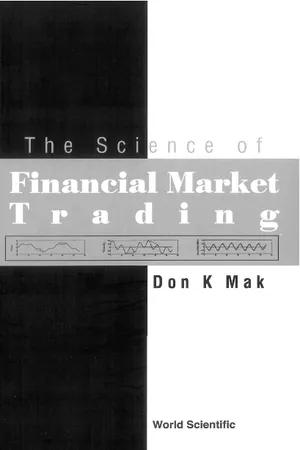
- 260 pages
- English
- PDF
- Available on iOS & Android
Science Of Financial Market Trading, The
About this book
In this book, Dr Mak views the financial market from a scientific perspective. The book attempts to provide a realistic description of what the market is, and how future research should be developed. The market is a complex phenomenon, and can be forecasted only with errors — if that particular market can be forecasted at all.The book reviews the scientific literatures on the financial market and describes mathematical procedures which demonstrate that some markets are non-random. How the markets are modeled — phenomenologically and from first principle — is explained.It discusses indicators, which are quite objective, rather than price patterns, which are rather subjective. Similarities between indicators in market trading and operators in mathematics are noted, and particularly, between oscillator indicators and derivatives in Calculus. It illustrates why some indicators, e.g., Stochastics, have limited usage. Several new indicators are designed and tested on theoretical waveforms to check their validity and applicability. The indicators have a minimal time lag, which is significant for trading purposes. Common market behaviors like divergences between price and momentum are explained. A skipped convolution technique is introduced to allow traders to pick up market movements at an earlier time. The market is treated as a nonlinear phenomenon. Forecasting of when the market is going to turn is emphasized.
Frequently asked questions
- Essential is ideal for learners and professionals who enjoy exploring a wide range of subjects. Access the Essential Library with 800,000+ trusted titles and best-sellers across business, personal growth, and the humanities. Includes unlimited reading time and Standard Read Aloud voice.
- Complete: Perfect for advanced learners and researchers needing full, unrestricted access. Unlock 1.4M+ books across hundreds of subjects, including academic and specialized titles. The Complete Plan also includes advanced features like Premium Read Aloud and Research Assistant.
Please note we cannot support devices running on iOS 13 and Android 7 or earlier. Learn more about using the app.
Information
Table of contents
- Contents
- Preface
- 1. Introduction
- 2. Is the Market Random ?
- 3. Models of the Financial Markets
- 4. Signals and Indicators
- 5. Trending Indicators
- 6. Oscillator Indicators
- 7. Vertex Indicators
- 8. Various Timeframes
- 9. Wavelet Analysis
- 10. Other New Techniques
- 11. Trading Systems
- 12. Financial Markets are Complex
- Appendix 1 Time Series Analysis
- Appendix 2 Signals and Systems
- Appendix 3 Low Pass Filters
- Appendix 4 High Pass Filters
- Appendix 5 Vertices
- Appendix 6 Downsampling and Upsampling
- Appendix 7 Wavelets
- Appendix 8 Skipped Convolution and Forecasting
- Bibliography
- Index